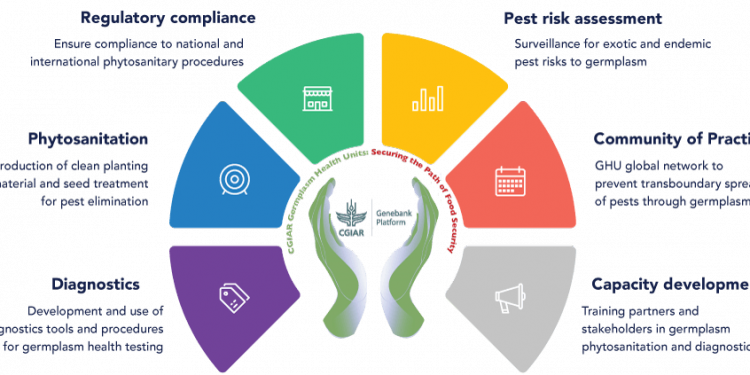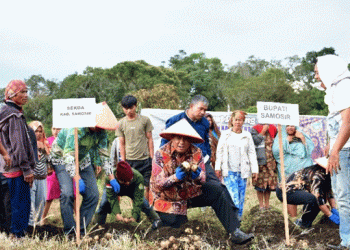As part of measures to address the inadvertent spread of pests with germplasm distribution, Germplasm Health Units (GHU) in CGIAR are organizing a week-long awareness program on “phytosanitary safety for pest prevention” on 9–13 November. Plants and seeds are known to harbor various pests (bacteria, fungi, viruses, insects, nematodes, and other harmful biotic agents) that can spread into new territories along with germplasm transportation.

Introduced pests pose a major threat to agricultural production, trade, and native biodiversity. In the last decade alone, several epidemics and pandemics were caused by introduced pests, including maize lethal necrosis, fall armyworm, banana bunchy top, potato purple top, Fusarium wilt TR4, wheat blast, potato cyst nematode, and many others, causing severe losses exceeding multimillion US dollars. Pest spread through germplasm (seed and vegetative propagules) is one of the important pathways for the transboundary spread of pests.
This is a source of major concern for CGIAR Centers that distribute large numbers of samples from its genebanks and breeding programs to international crop improvement and biodiversity conservation programs, many of which are in developing countries and biodiversity hotspots, lacking sufficient phytosanitary capacity to prevent pest entry or respond to pest outbreaks. In recognizing the hazards of pest risks, the Centers had set up GHUs to avert the spread of quarantine pests with germplasm transfers, prevent pest outbreaks, and safeguard biodiversity.
The GHUs ensure the safe and efficient transfer of germplasm as this is crucial for the Centers’ international programs and delivery of public goods under the FAO International Plant Protection Convention (IPPC) and national quarantine regulations enforced by the National Plant Protection Organizations (NPPOs).
These GHUs also serve as the Centers’ gateway for germplasm exchange by ensuring compliance with the IPPC procedures and the International Standards for Phytosanitary Measures (ISPMs) used by NPPOs to prevent the introduction, and control the spread of pests along with plants or plant products. The Centers spend about US$10 million each for germplasm health testing and production of pest-free planting material for safe international transfers.
The CGIAR Phytosanitary Awareness Week was organized in partnership with the United Nations (UN) Food and Agriculture Organization (FAO), International Plant Protection Convention (IPPC), Regional Plant Protection Organizations (RPPOs), National Plant Protection Organizations (NPPOs), and Crop Trust, with the theme “Phytosanitary Safety for Prevention of Transboundary Spread of Pests and Pathogens”. It comes at a time when the UN has declared the year 2020 as the International Year of Plant Health (IYPH 2020), to raise awareness about plant health and the impact of healthy plants and forests on food security, poverty, economic development, and sustainability.

The week-long event features a series of webinars planned to discuss the state of global efforts to contain the spread of invasive transboundary pests; best practices used in CGIAR GHUs; engagement and collaboration with national and international plant health organizations, and others. These webinars will also look at future scenarios and needs for protecting germplasm health and biorisk mitigation during germplasm transfer events.
The webinars will focus on the challenges and opportunities existing in the African, Asia-Pacific, and Latin American regions. The key experts and advocates that will be attending will also explore ways to work together with national and global phytosanitary communities to prevent the spread of transboundary pests; compliance to phytosanitary controls in seed production and international seed distribution activities; and knowledge and technological advances in phytosanitation and diagnostics.
The GHU seminar series kicks off with a global plenary session on 9 November 2020, focused on three presentations on IYPH; FAO-CGIAR international collaboration in tackling transboundary pests; and the role of CGIAR Germplasm Health component of the Genebank Platform in preventing the transboundary spread of pests and pathogens and safe international transfers of germplasm for food and agricultural R4D initiatives around the world.
The Asian session on 10 November will focus on phytosanitary implications of global exchange of crop germplasm, and emerging crop pests and pathogens in Asia. New plant pests and pathogens can have a potential impact on livelihoods and food security. Locust outbreaks and increasing infestation of fall armyworm are of great concern in the region. Wheat blast, Fusarium oxysporum Tropical Race 4, Bactrocera zonata (the peach fruit fly), brown plant hoppers (BPH)—a major pest of rice, and UG99—a virulent strain of wheat stem rust, are the other potential threats to agriculture. The seminars highlight the collaborative role of CGIAR GHUs and NPPOs in preventing the introduction and spread of pests of quarantine significance.
The Latin American session on 11 November will focus on phytosanitary issues of importance in Latin America, where climate change and new invasive pest introductions such as potato purple top disease, Fusarium oxysporum Tropical Race 4, and citrus Huanglongbing are changing pest dynamics and threatening crops across the continent. The seminars highlight the role of CGIAR GHUs and NPPOs and RPPOs in preventing the introduction and spread of these pests.
The African session on 12 November will focus on emerging pest and pathogen threats to food staples, trees, and forages in Africa. Sub-Saharan Africa has been grappling with several introduced exotic threats such as maize lethal necrosis, banana bunchy top, Fusarium oxysporum Tropical Race 4, fall armyworm, cassava brown streak, and Tuta abosluta. The seminars highlight the role of CGIAR GHUs and NPPOs and RPPOs in prevention and containing the transboundary spread of emerging pests and pathogens.
The closing session on Friday, 13 November will present key findings and recommendations from each webinar session, followed by an “expert panel” discussion on the needs for enhancing phytosanitary safety to prevent the transboundary spread of pests and pathogens, and key recommendations and way forward for GHU future action.
With the GHUs having facilitated about 1,950 events of international germplasm transfers from genebanks, and breeding programs, across the world, reaching about 100 countries per year, the GHU Phytosanitary Week will strategize on future pest risk scenarios in the context of climate change, and identify the technologies, and partnerships appropriate for addressing current and future biorisks to plant and germplasm health.
Web: https://www.genebanks.org/news-activities/news/ghu-webinar/
YouTube Streaming: https://bit.ly/2TZzlGa








